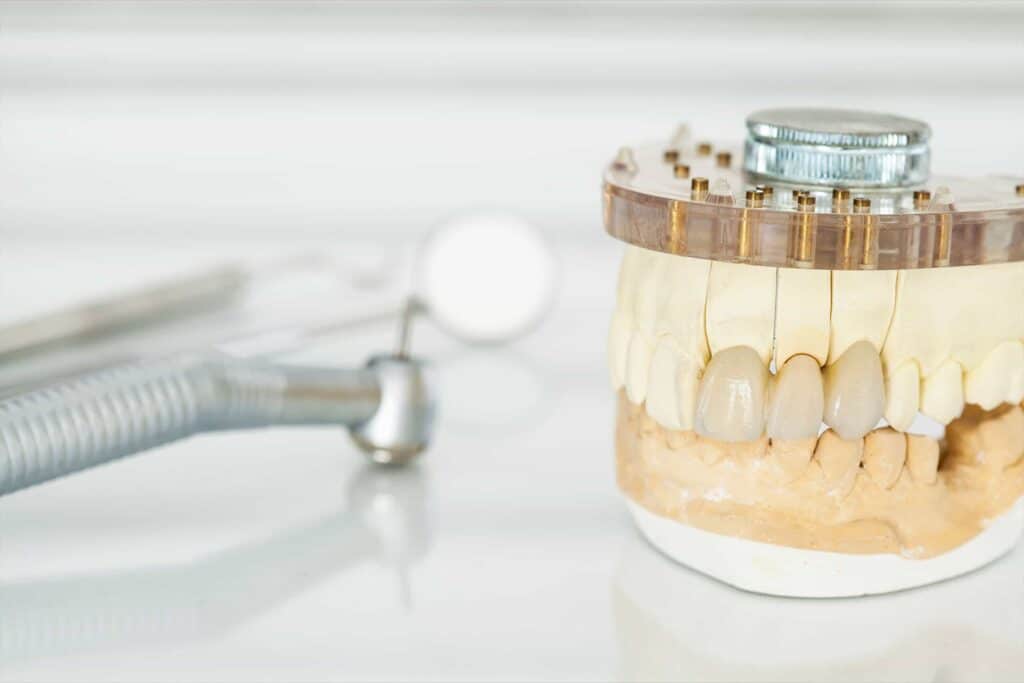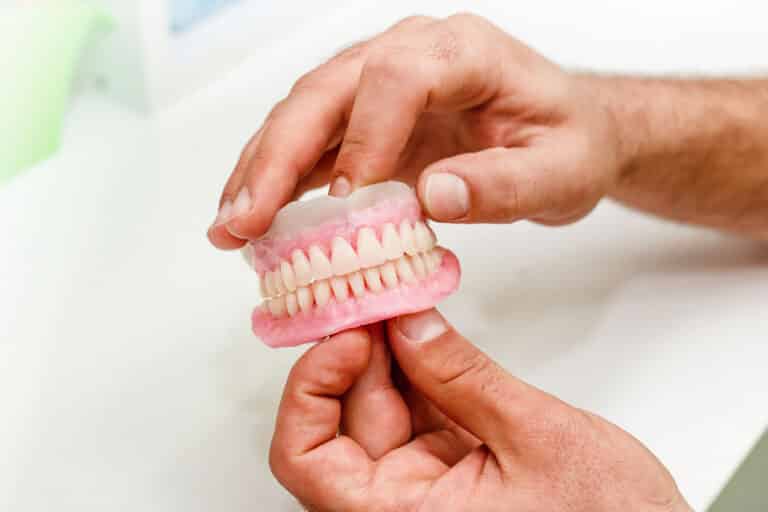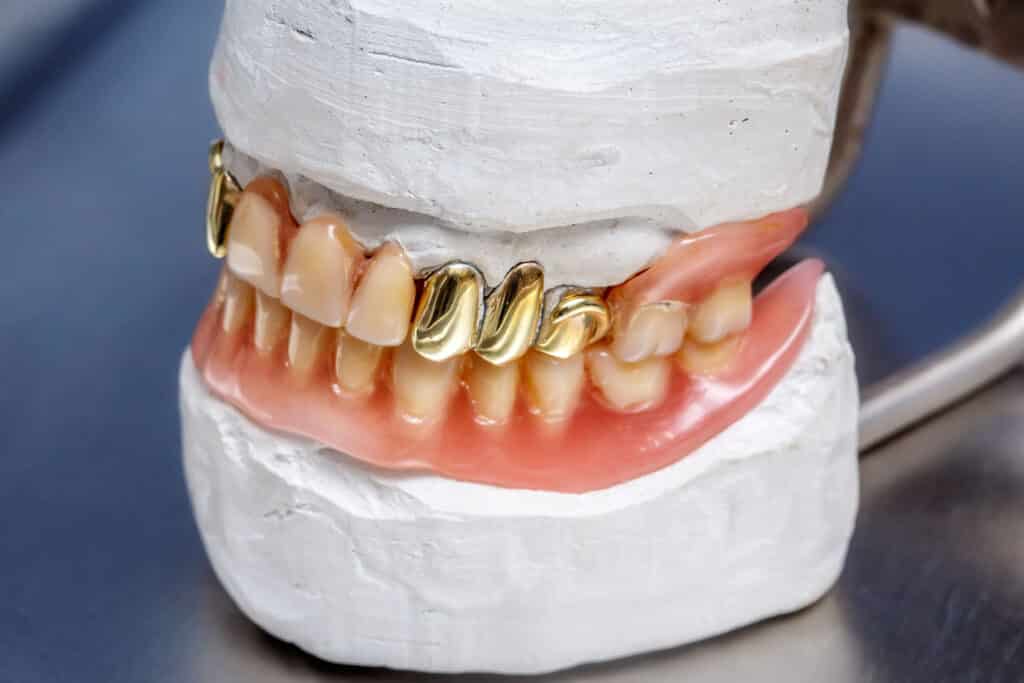Gingivitis is a mild form of gum disease where inflammation and irritation of the gums occurs. It is typically caused by the buildup of dental plaque, a sticky byproduct of bacteria that forms on teeth and gum tissue.
If left untreated, gingivitis can progress to periodontal disease, a more severe form of gum disease that can cause irreversible damage to the gums and bones that support the teeth. Symptoms of gingivitis include red, swollen, and tender gums that bleed easily, especially during brushing or flossing.
The best way to prevent and treat gingivitis is to maintain good oral hygiene practices, such as brushing twice daily, flossing, and getting cleanings by a dental professional. Some people who are more prone to periodontal diseases, such as those with a family history, may need additional tools to prevent gum disease. These can include water flossers and mouth rinses.
If the gingivitis has progressed to periodontal disease, your dentist may recommend more intensive treatment, such as deep cleaning or periodontal surgery. This typically occurs when there is damage to the bones supporting the teeth.
Gingivitis Appearance and Symptoms
Gingivitis, though it can present itself in various ways, can cause several visible symptoms that dental professionals notice in the appearance of the gums. Here are some of the most common signs of gingivitis.
Redness
Healthy gum tissue should have a light pink appearance. Unhealthy gums appear redder than usual, usually around the base of the teeth.
Swelling
In general swollen tissues are one of the signs and symptoms of disease. The gums are no different. Gums can become swollen and puffy, making them appear more prominent than usual.
Bleeding gums
During regular daily use and maintenance, the gums should not bleed. If the gums bleed easily, one of the gingival diseases is present. Bleeding gums can also occur with advanced gum disease. Your dental office will be able to tell if the gum disease is in the early stages or more severe.
Bad Breath
Since one of the causes of gingivitis is a lack of proper hygiene, it can contribute to a persistent bad taste in the mouth and bad breath. However if the bad breath, or halitosis, is really bad, it may be an indication of more serious bacterial infection of the underlying bone.
Receding Gums
Typically receding gums is a sign that the disease is more severe than just gum inflammation. While you can have just gingivitis with receded gums, actively receding gums usually is an indication of something more serious.
Sensitive Teeth
If not a result of cavities, or dental caries, sensitive teeth only occurs when a significant amount of receding gums has occurred. The teeth can not only become more sensitive to hot, cold, and sweet, but simply touching or brushing near the gumline can cause sensitivity. This may not be one of the gingivitis symptoms, so if your teeth are sensitive, seek professional advice.
If you notice any of these symptoms, seeing a dentist or dental hygienist for an evaluation is essential. They can help determine if you have gingivitis or another gum disease and recommend appropriate treatment to prevent further damage.
What Causes Gingivitis?
The most common cause of gingivitis is a buildup of plaque on the teeth and gums. Plaque is a sticky film of bacteria that hardens into tartar if not removed through regular brushing and flossing.
Tartar buildup can lead to gingivitis and progresses to periodontal disease if left untreated. Several factors can increase the risk of developing gingivitis, and these include:
Poor Oral Hygiene
The most common cause of gingivitis, inadequate brushing and flossing allows bacterial plaque to accumulate. This is one of the biggest risk factors of gingivitis.
Smoking and Chewing tobacco
Smoking can irritate the gums and reduce blood flow. This contributes to gingivitis amongst other oral health problems. Smoking and
Diabetes
Diabetes, especially uncontrolled diabetes, can increase the risk of developing gum disease. It is one of the biggest systemic diseases that can affect oral health.
Hormonal Changes
Changes during pregnancy, puberty, and menopause can make the gums more susceptible to gingivitis. Oral contraceptives may initially contribute to hormonal changes as well.
Medications
The most common side effect of all medications is xerostomia or dry mouth. While certain medications may contribute more to dry mouth, all medications contribute to dry mouth and increase the risk of gum disease.
Genetic factors
Those with a family history of the various types of periodontal disease are going to be more susceptible.
Age
As we age, our gums will generally recede, making it easier for bacteria to build up and cause gum disease. Additionally we are more susceptible to chronic diseases and manual dexterity tends to be poorer as everyone ages.
Poor Nutrition
A diet lacking essential vitamins and nutrients can weaken the immune system. This can contribute to the body’s ability to fight infection. A whole-food diet focusing on grains, fruits, lean meats, and vegetables can help!
Maintaining good oral hygiene and visiting a dentist regularly for cleanings and check-ups can help prevent gingivitis and other gum diseases. If you notice a change between cleanings, don’t hesitate to schedule an appointment as soon as possible!
The Difference Between Gingivitis and Periodontitis
While gingivitis and periodontitis are gum disease, they differ in severity and the extent of damage to the gums and bones supporting structures of the teeth. Gingivitis is the milder and more common form of gum disease caused by plaque buildup on the teeth and gums, which is reversible.
The symptoms of gingivitis include red, swollen, and tender gums that bleed easily, especially during brushing or flossing. Patients can often reverse gingivitis with good oral hygiene practices, such as regular brushing and flossing and professional cleanings from a dentist or dental hygienist.
On the other hand, periodontitis is a more severe form of gum disease that can cause irreversible damage to the gums and supporting structures of the teeth. In addition to the symptoms of gingivitis, periodontitis erodes away at the bone.
Over time, this can lead to the breakdown of the bone and tissue that support the teeth. If severe enough, this can result in tooth loss in adults. The treatment for periodontitis depends on the severity of the disease.
In the early stages, a dentist or periodontist may recommend scaling and root planing, also known as a deep cleaning. During this procedure, scaling removes tartar from the surfaces of teeth both above and below the gums. This removes bacterial footholds in the oral cavity, making it harder for bacteria to affect your dental health.
In more advanced cases, surgical procedures may be necessary to repair or replace damaged tissue and bone. Sometimes this involves various types of grafting and while it seems daunting, it may be necessary to properly restore oral health.
It’s important to catch gum disease early and seek treatment to prevent it from progressing to more severe forms. Regular dental cleanings and a dental exam that involves periodontal probing are some of the best ways to catch the early signs of gum disease.
Treating Gingivitis
The treatment for gingivitis varies depending on the severity of the disease. Mild cases of gingivitis can often be treated with improved oral hygiene practices and regular professional cleanings, and more severe cases may require more aggressive treatment.
However one goes from mild symptoms to more severe symptoms, treatment becomes more involved. As the gum disease becomes worse, gingivitis morphs into periodontitis and requires more aggressive treatment.
Mild Gum Disease
In mild cases of gingivitis, the first step is to improve oral hygiene practices. This includes brushing twice daily with fluoride toothpaste, flossing daily, and using an antiseptic mouthwash to kill bacteria. A dentist or dental hygienist will also perform a professional cleaning to remove plaque and tartar buildup. The bone is unaffected and the most severe symptoms involve bleeding, sore and puffy gums.
Moderate Gum Disease
For moderate cases of gum disease, gingivitis may have morphed into mild periodontitis and more intensive cleanings may be necessary. This process may involve scaling and root planing, a deep cleaning procedure that removes plaque and tartar deep in the gum line. You might also receive a prescription for antibiotics to kill bacteria and reduce inflammation.
Severe Gum Disease
As gingivitis becomes full blown periodontitisi, surgical intervention may be necessary to remove damaged tissue and bone. Flap surgery could be required in which the gums are lifted to allow the dentist or periodontist to clean the teeth and roots. Also, bone and tissue grafts could be possible to replace damaged tissue and bone.
Whatever your dentist recommends, make sure you speak with them in-depth regarding the details of your procedure so you know what to expect. Preparation for any dental appointment is critical!
How Can You Prevent Gingivitis?
Preventing gingivitis requires a combination of good oral hygiene practices and a healthy lifestyle. To keep your teeth and gums healthy, consider adopting the following practices!
Brush and Floss Regularly
Brush your teeth twice a day with fluoride toothpaste and floss daily to remove plaque and food particles from between your teeth and gums.
Use an Antiseptic Mouthwash
Use an antiseptic mouthwash to kill bacteria and freshen your breath. You can ask your dentist for product recommendations, but you can typically find such products in your local drugstore.
Eat a Healthy Diet
Eat a well-balanced diet rich in vitamins and nutrients, and avoid sugary and processed foods that can increase the risk of gum disease. If you do reach for dessert, don’t hesitate to brush after!
Avoid Smoking and Chewing Tobacco
Not only are they detrimental to your overall health, but smoking and tobacco can irritate the gums and reduce blood flow, making it harder for your immune system to react when needed.
Manage Stress
Stress can weaken the immune system and make it harder for the body to fight off infections, and gum disease is not an exception to that rule. Sleep well and make plenty of time for relaxation and activities you enjoy.
Consistent Dental Checkups
Regular dental check-ups and cleanings can help prevent gingivitis by removing plaque and tartar buildup and detecting early signs of gum disease.
Electric Toothbrush
Electric toothbrushes are often more effective at removing plaque than manual toothbrushes. Although not required, electric toothbrushes require less manual dexterity and work to properly clean teeth.
Adhering to a few simple lifestyle changes can reduce your risk of developing gingivitis and maintain healthy gums and teeth. If you notice any signs of gum disease, such as red or swollen gums that bleed easily, immediately make an appointment with your dentist.
Health Conditions Associated with Gingivitis
There are actually several health conditions associated with gingivitis, and they include.
Diabetes
People with diabetes are at a higher risk of developing gum disease, including gingivitis, because high blood sugar levels can weaken the immune system and make it harder for the body to fight off infection.
Heart Disease
Some studies have suggested a link between gum disease and heart disease. It is thought that the inflammation caused by gum disease may contribute to the development of cardiovascular disease.
Respiratory Disease
Bacteria from the mouth can be inhaled into the lungs, potentially causing respiratory infections or worsening existing respiratory conditions, such as chronic obstructive pulmonary disease (COPD).
There are also some thoughts that this can worsen symptoms of COVID-19 infections as well.
Rheumatoid Arthritis
People with rheumatoid arthritis are more likely to develop gum disease, and studies have suggested that there may be a link between the two conditions.
Dementia
Some research has suggested that gum disease may be linked to an increased risk of cognitive decline and dementia in older adults.
Pregnancy Complications
Pregnant women with gingivitis may be at higher risk of complications such as preterm birth or low birth weight.
Many of these health conditions revolve around the thought that bacteria in your mouth can get access to the bloodstream when gum disease is present. When chronically present, bacteria can affect your heart, lungs, brain, and other vital organs.
Regardless of where you are in life or the current condition of your teeth, dental checkups and regular screenings for gum disease remain imperative to your health. Have you scheduled your cleaning?





